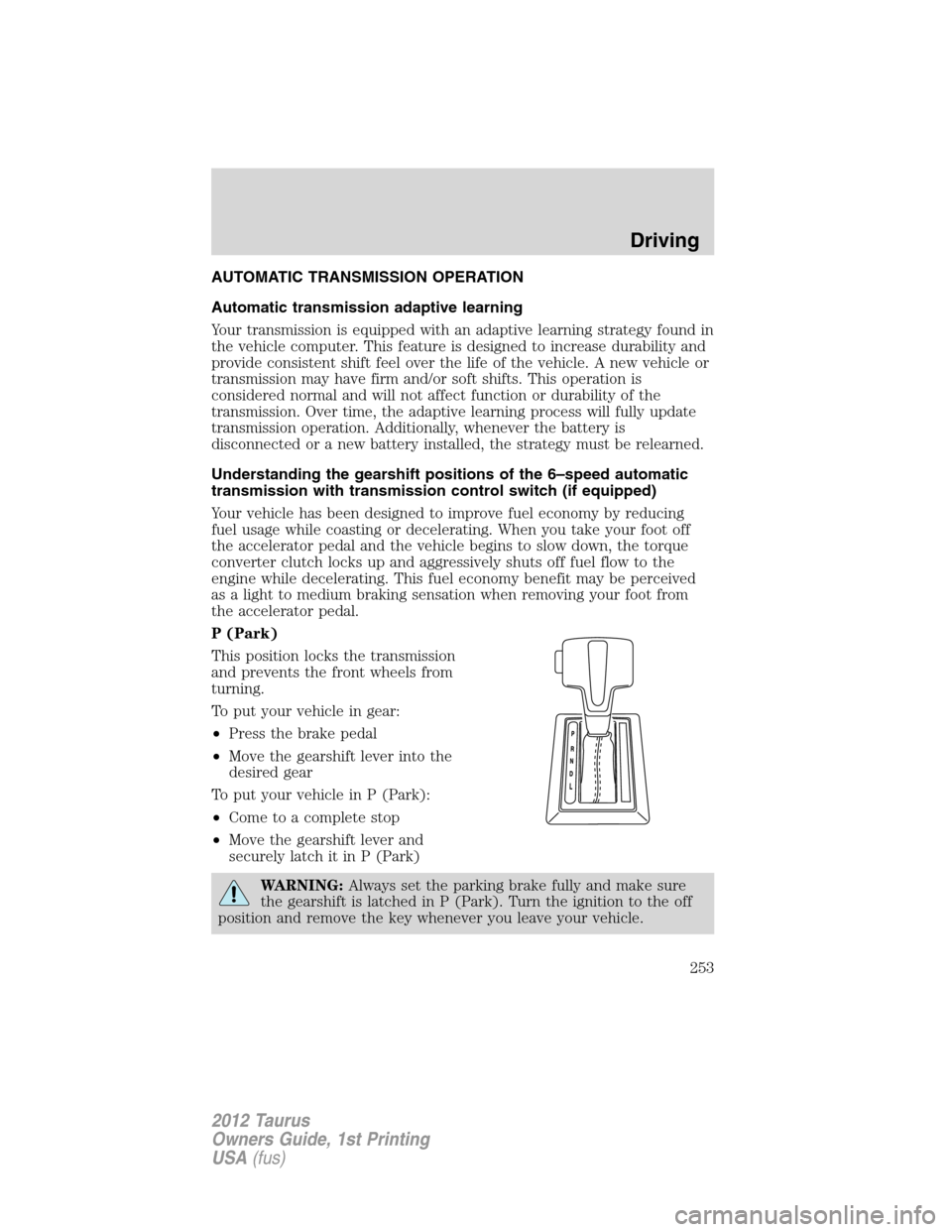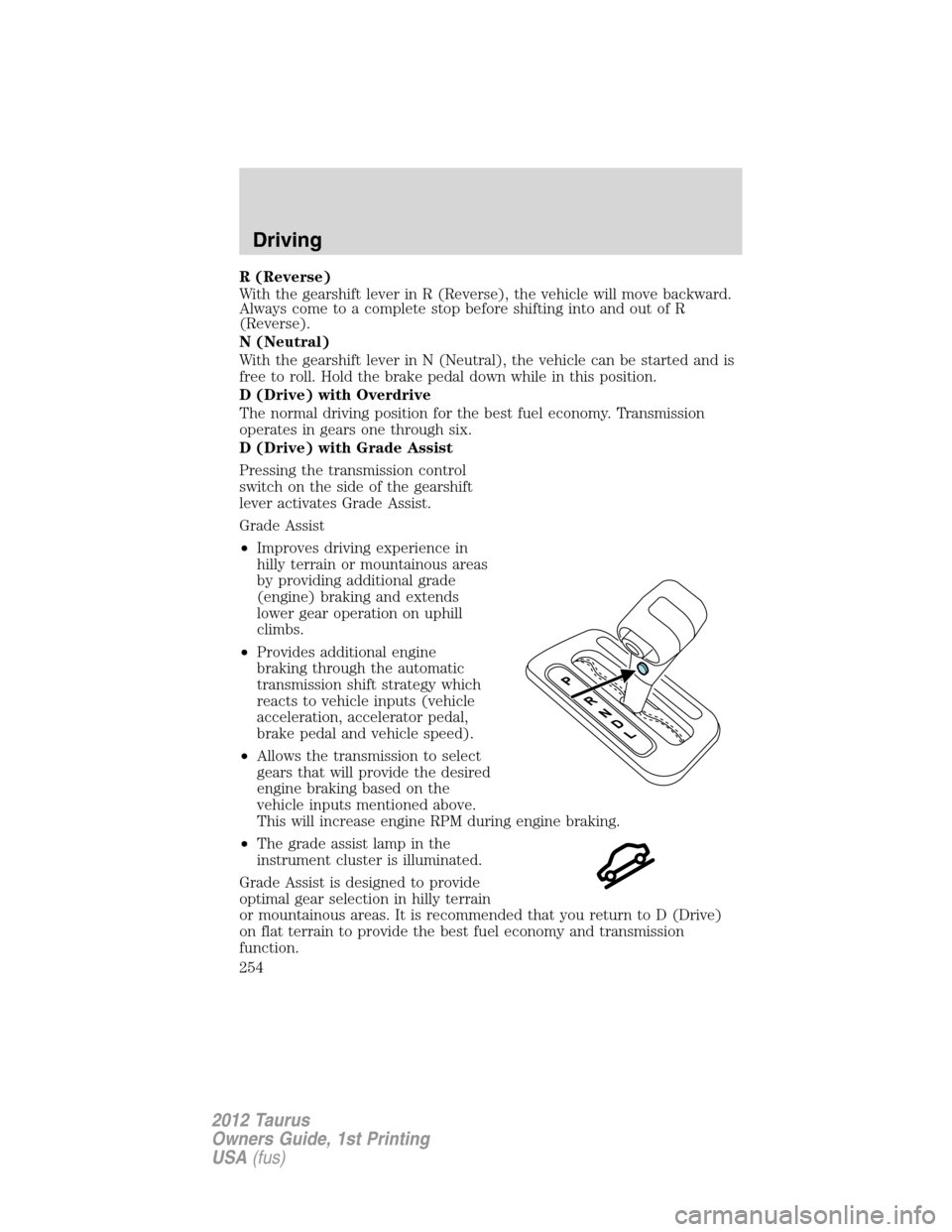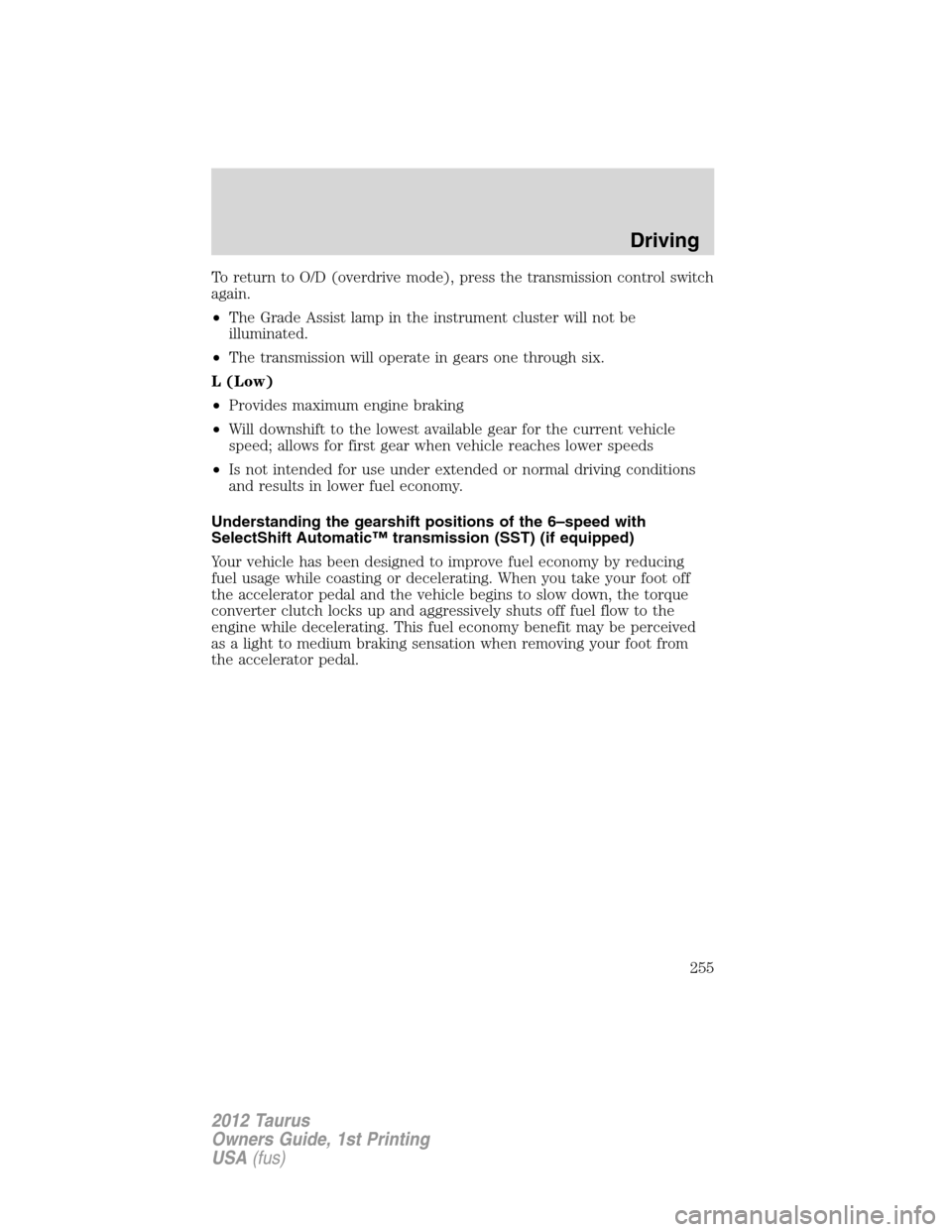Page 234 of 406
If you tow your vehicle with all four wheels on the ground, follow these
instructions:
•Tow only in the forward direction.
•Release the parking brake.
•Place the transmission shift lever in N (Neutral).
•Place the ignition in the accessory position (refer toStartingin the
Drivingchapter).
•Do not exceed 65 mph (105 km/h)
•Start the engine and allow it to run for five minutes at the beginning
of each day and at each fuel stop.
Tires, Wheels and Loading
234
2012 Taurus
Owners Guide, 1st Printing
USA(fus)
Page 235 of 406

STARTING
Positions of the ignition (if equipped)
If your vehicle is equipped with a push button start system, refer to
Push button start systemin this section for ignition modes.
1. Off— locks the gearshift lever
and allows key removal. This
position also shuts the engine and
all electrical accessories off.Note:
In order to switch off the engine
while the vehicle is in motion, shift
to neutral and use the brakes to
bring the vehicle to a safe stop.
After the vehicle has stopped, turn the engine off and shift into park.
Then, turn the key to the accessory or off position.
2. Accessory— allows the electrical accessories such as the radio to
operate while the engine is not running.
3. On— all electrical circuits operational. Warning lights illuminated. Key
position when driving.
4. Start— cranks the engine. Release the key as soon as the engine
starts.
Starting your vehicle
This system meets all Canadian interference-causing equipment standard
requirements regulating the impulse electrical field strength of radio
noise.
Don’t press the accelerator before or during starting. Only use the
accelerator when you have difficulty starting the engine. For more
information on starting the vehicle, refer toStarting the enginein this
chapter.
To avoid potential transmission damage at extremely cold temperatures
(below -20°F [-30°C]), it is recommended that the vehicle be warmed up
to normal operating temperature before driving at highway speeds above
50 mph (80 km/h). Normal operating temperature is normally reached
after 10 minutes of moderate driving or idling.
WARNING:Extended idling at high engine speeds can produce
very high temperatures in the engine and exhaust system,
creating the risk of fire or other damage.
Driving
235
2012 Taurus
Owners Guide, 1st Printing
USA(fus)
Page 253 of 406

AUTOMATIC TRANSMISSION OPERATION
Automatic transmission adaptive learning
Your transmission is equipped with an adaptive learning strategy found in
the vehicle computer. This feature is designed to increase durability and
provide consistent shift feel over the life of the vehicle. A new vehicle or
transmission may have firm and/or soft shifts. This operation is
considered normal and will not affect function or durability of the
transmission. Over time, the adaptive learning process will fully update
transmission operation. Additionally, whenever the battery is
disconnected or a new battery installed, the strategy must be relearned.
Understanding the gearshift positions of the 6–speed automatic
transmission with transmission control switch (if equipped)
Your vehicle has been designed to improve fuel economy by reducing
fuel usage while coasting or decelerating. When you take your foot off
the accelerator pedal and the vehicle begins to slow down, the torque
converter clutch locks up and aggressively shuts off fuel flow to the
engine while decelerating. This fuel economy benefit may be perceived
as a light to medium braking sensation when removing your foot from
the accelerator pedal.
P (Park)
This position locks the transmission
and prevents the front wheels from
turning.
To put your vehicle in gear:
•Press the brake pedal
•Move the gearshift lever into the
desired gear
To put your vehicle in P (Park):
•Come to a complete stop
•Move the gearshift lever and
securely latch it in P (Park)
WARNING:Always set the parking brake fully and make sure
the gearshift is latched in P (Park). Turn the ignition to the off
position and remove the key whenever you leave your vehicle.
Driving
253
2012 Taurus
Owners Guide, 1st Printing
USA(fus)
Page 254 of 406

R (Reverse)
With the gearshift lever in R (Reverse), the vehicle will move backward.
Always come to a complete stop before shifting into and out of R
(Reverse).
N (Neutral)
With the gearshift lever in N (Neutral), the vehicle can be started and is
free to roll. Hold the brake pedal down while in this position.
D (Drive) with Overdrive
The normal driving position for the best fuel economy. Transmission
operates in gears one through six.
D (Drive) with Grade Assist
Pressing the transmission control
switch on the side of the gearshift
lever activates Grade Assist.
Grade Assist
•Improves driving experience in
hilly terrain or mountainous areas
by providing additional grade
(engine) braking and extends
lower gear operation on uphill
climbs.
•Provides additional engine
braking through the automatic
transmission shift strategy which
reacts to vehicle inputs (vehicle
acceleration, accelerator pedal,
brake pedal and vehicle speed).
•Allows the transmission to select
gears that will provide the desired
engine braking based on the
vehicle inputs mentioned above.
This will increase engine RPM during engine braking.
•The grade assist lamp in the
instrument cluster is illuminated.
Grade Assist is designed to provide
optimal gear selection in hilly terrain
or mountainous areas. It is recommended that you return to D (Drive)
on flat terrain to provide the best fuel economy and transmission
function.
Driving
254
2012 Taurus
Owners Guide, 1st Printing
USA(fus)
Page 255 of 406

To return to O/D (overdrive mode), press the transmission control switch
again.
•The Grade Assist lamp in the instrument cluster will not be
illuminated.
•The transmission will operate in gears one through six.
L (Low)
•Provides maximum engine braking
•Will downshift to the lowest available gear for the current vehicle
speed; allows for first gear when vehicle reaches lower speeds
•Is not intended for use under extended or normal driving conditions
and results in lower fuel economy.
Understanding the gearshift positions of the 6–speed with
SelectShift Automatic™ transmission (SST) (if equipped)
Your vehicle has been designed to improve fuel economy by reducing
fuel usage while coasting or decelerating. When you take your foot off
the accelerator pedal and the vehicle begins to slow down, the torque
converter clutch locks up and aggressively shuts off fuel flow to the
engine while decelerating. This fuel economy benefit may be perceived
as a light to medium braking sensation when removing your foot from
the accelerator pedal.
Driving
255
2012 Taurus
Owners Guide, 1st Printing
USA(fus)
Page 256 of 406
P (Park)
This position locks the transmission
and prevents the front wheels from
turning.
To put your vehicle in gear:
•Press the brake pedal
•Move the gearshift lever into the
desired gear
To put your vehicle in P (Park):
•Come to a complete stop
•Move the gearshift lever and
securely latch it in P (Park)
WARNING:Always set the parking brake fully and make sure
the gearshift is latched in P (Park). Switch the ignition off and
remove the key whenever you leave your vehicle.
R (Reverse)
With the gearshift lever in R (Reverse), the vehicle will move backward.
Always come to a complete stop before shifting into and out of R
(Reverse).
N (Neutral)
With the gearshift lever in N (Neutral), the vehicle can be started and is
free to roll. Hold the brake pedal down while in this position.
D (Drive)
The normal driving position for the best fuel economy. Transmission
operates in gears one through six.
Driving
256
2012 Taurus
Owners Guide, 1st Printing
USA(fus)
Page 257 of 406
M (Manual)
With the gearshift lever in M
(Manual), the driver can change
gears up or down (without a clutch)
as desired. This is called SelectShift
Automatic™ transmission (SST)
mode. By moving the gearshift lever
from drive position D (Drive) to M
(Manual) you now have control of
selecting the gear you desire using
the paddle shifters on the steering
wheel.
To return to normal D (Drive)
position, move the shift lever back
from M (Manual) to D (Drive). The transmission will operate in gears
one through six.
Paddle shifters
The paddle shifters allow you to shift gears quickly, without taking your
hands off the steering wheel.
1. To manually downshift the
transmission with the gearshift lever
in M (Manual), press the paddle
shifters forward.
2. To manually upshift the
transmission with the gearshift lever
in M (Manual), pull the paddle
shifters rearward.
Driving
257
2012 Taurus
Owners Guide, 1st Printing
USA(fus)
Page 260 of 406

The RSS automatically turns on when the gearshift lever is placed in R
(Reverse) and the ignition is on. An RSS control on the instrument panel
allows the driver to turn the RSS on and off. To turn the RSS off, refer
toMessage centerin theInstrument clusterchapter for more
information.
Keep the RSS sensors (located on the rear bumper/fascia) free
from snow, ice and large accumulations of dirt (do not clean the
sensors with sharp objects). If the sensors are covered, it will
affect the accuracy of the RSS.
If your vehicle sustains damage to the rear bumper/fascia, leaving
it misaligned or bent, the sensing zone may be altered causing
inaccurate measurement of obstacles or false alarms.
REARVIEW CAMERA SYSTEM (IF EQUIPPED)
The rearview camera is located on the trunk, under the spoiler for the
SHO, or under the Ford badge for all other models.
The camera system provides a video image which appears in the rear
view mirror or on the navigation screen (if equipped), of the area behind
the vehicle. It adds assistance to the driver while reversing or reverse
parking the vehicle.
To use the camera system, place the transmission in R (Reverse); an
image will display in the rear view mirror or on the navigation screen (if
equipped). The area displayed on the screen may vary according to the
vehicle orientation and/or road condition.
Driving
260
2012 Taurus
Owners Guide, 1st Printing
USA(fus)